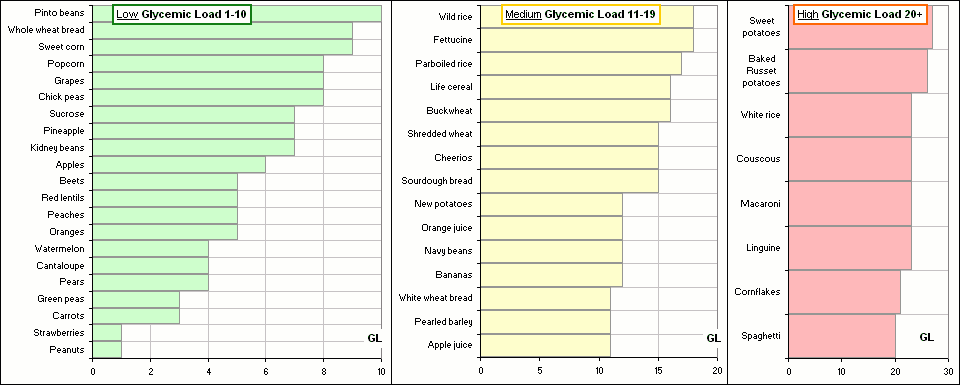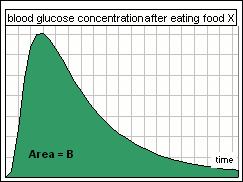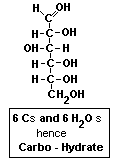| Glycemic Stuff ... based in part upon the info at mendosa.com (with permission) |
Yesterday I went to the doctor. He said my blood sugar was high and I could become a diabetic if I didn't do something about my sugar intake and he talked
about some glycemic stuff and he said that I need to do more exercise and lose weight, so I surfed the web ...
>That was your exercise? 
Pay attention! I needed to learn more about that glycemic stuff:
- When you eat bread or fruit or pasta, the food is broken down and produces energy for your body in the form of glucose.
- The Glycemic Index measures how quickly the body converts carbohydrates in foods to glucose (thereby elevating blood sugar).
- The Glycemic Index was conceived in 1981 by David Jenkins and fellow researchers at the University of Toronto.
- The GI is given on a scale of 0 to 100 (with glucose = 100 because it's ... uh, already glucose, eh?).
- But GI may be misleading.
For example, suppose that a "normal" serving of food X is 100 grams, and the carbohydrates in that food have a huge GI (like 90), should you be worried? Not if 100 grams of that food contain just 0.1 grams of those high GI carbohydrates
- Such foods (such as watermelon) would have a high GI because of the type of carbs they contain.
But a "normal" serving should not be considered as a high glycemic food ... hence the notion of Glycemic Load which measures
not only the Glycemic Index of the carbs, but also the amount of carbs in a normal serving
- The GL is the product of the GI multiplied by the grams of carbohydrates in a "normal serving" (whatever normal means).
For the above example, GL = 90 (0.1) = 9 and that ain't bad, eh?
So that, even with a high GI, if the amount of carbs is low, the product GL may be small (see watermelon, below). - I guess one should be more concerned with the Glycemic Load than with the Glycemic Index.
(For example, ice cream has a Glycemic Index of 37 but (for "normal" serving) a Glycemic Load of only 4.) - Finally ... Mamma mia! It's not fair that pasta is a high Glycemic Load food %#$@!^&?!
One other thing: High Glycemic foods increase blood sucrose.
The body's response to this is to secrete more insulin (via the pancreas which attempts to control blood glucose).
Anyway, here's the table that Rick Mendosa has:
(Glycemic Load, Glycemic Index) | 1 - 55 | 56 - 69 | 70 - 100 |
1 - 10 |
11 - 19 |
20 and over |
Here's a picture:

>Peanuts, eh?
See also:
- Glycemic Index a Table
- USDA carbohydrate content in .pdf format
- Publication by Nutrition Unit Univ. of Sydney - where the notion of Glycemic Load began :^) (abstract)
- about GI and GL Linus Pauling Institute
- the South Beach diet based upon Glycemic stuff
- Table of Glycemic Index / Load an extensive list, from the American Journal of Clinical Nutrition
- the G.I Diet for losing weight
>So how do you measure this Glycemic Index?
For example, a cup of pasta might have 17 grams of carbohydrates but only 9 grams of Net Carbs, the other 8 grams being fibre. And sugar alcohol? They're sweeteners/sugar substitutes and have neither sugar nor alcohol. ** Usually measured in milligrams per deciliter (mg/dl). |  Figure 1 |
|
>That's the Glycemic Index?
That's the way I understand it. >That glucose is like regular sugar, eh? Regular table sugar is sucrose. It's more complicated. Glucose is a simple carbohydrate, like Figure 2: C6H12O6 = (CH2O)6 Sugar alcohols, by the way, contain molecules which look like sugars and alcohol ... hence the name. If your body can't find enough carbohydrates in your food, it uses up body fat.
|  Figure 2 |
| Hydrogenated Oils and Trans Fatty Acids |
Let me mention what you should not eat. Well, at least you should reduce your consumption of these items ...
>Reduce? Why not eliminate?
Eliminate hamburgers and fries?
>Uh ... let's just reduce, okay?
- There are three kinds of fat: saturated, monounsaturated and polyunsaturated. (We'll get to these below.)
- Fats form the structures in our bodies: muscles, nerves, membranes and blood vessels and are essential for the absorption of fat-soluble vitamins A, D, E and K in the body.
- The American Heart Association recommends limiting fat Intake to 30% of Daily Calories. (A 2,000-calorie-a-day diet should not contain more than 65 grams or 585 calories of fat.)
- Although Essential Fatty Acids are the building blocks of fats (and play an important role, affecting almost every major organ, cell membrane production and immune system function), Trans Fatty Acids are deadly.
- Essential Fatty Acids are "essential" because they cannot be manufactured by the body and must therefore be included in your diet.
- The first patent for the hydrogenation of oil was in 1903 by William Norman. The first patent for hydrogenated cottonseed oil was in 1911. This was the year that Proctor and Gamble came out with Crisco oil.
- During the process of hydrogenation, hydrogen atoms are transferred to another part of the fatty acid molecule ... becoming a "trans" fatty acid.
- These changed molecular oils dramatically increase the risk of coronary heart disease, breast cancer, other types of cancers and auto immune diseases. These oils are harmful: example
- During the 1930's and 1940's, a dramatic increase was seen in a disease that looked like diabetes, but was not caused by a deficiency of insulin. A person with this disease did, in fact, produce enough insulin, but it was not effective in reducing blood sugar. The medical establishment named this new non-insulin dependent disease: type II diabetes.
>How does that hydrogenation work, and why use it at all?
In hydrogenation, oil is heated to very high temperatures, small particles of nickel or copper are added and hydrogen bubbles are passed through it (making it more dense). This destroys the essential fatty acids in the oil and replaces them with deformed trans fatty acids - and the human body is not well-equipped to deal with them! Besides, you can turn a vegetable oil into margarine by hydrogenation ... and it has a long shelf life.
Fully hydrogenated, the oil becomes a solid fat. If you stop part way, you get a semi-solid partially hydrogenated oil that has the consistency of butter - but it's a lot cheaper than butter!
>Are we talking fats or oils?
They're essentially the same, except that fats are solid at room temperature while oils are ...
>Liquid, eh? Okay. I gather that they're bad, eh?
Yes. Here are a few of the effects of hydrogenated oil / trans fatty acids:
- Lowers the "good" HDL cholesterol.
- Correlates to low birth weight in human infants.
- Increases blood insulin levels in humans, increasing risk for diabetes;
- Decreases levels of testosterone in males, increases level of abnormal sperm, and interferes with gestation in females.
- Decreases the response of the red blood cell to insulin ... a potentially undesirable effect in diabetics.
- Inhibits the function of membrane-related enzymes.
- Adversely interacts with conversion of plant omega-3 fatty acids.
- Increased breast cancer in women
- Increased heart disease in men and women
- Increases non-insulin dependent type diabetes disease
>Decreases testosterone in males? That does sound bad.
Yes, and ...
>What about that Cholesterol and HDL and Omega-3 fatty stuff?
| Cholesterol, HDL and Omega-3 |
- Cholesterol is a soft, fat-like, waxy substance found in the bloodstream and in all your body's cells.
It's normal and an important part of a healthy body. It's made by the liver.
It's found in all animal products: meat, poultry, seafood, eggs and dairy products.
(Vegetable products do not contain cholesterol, but they may be loaded with fat.)
It's used for producing cell membranes, some hormones, and other needed bodily functions.
But too high a level of cholesterol in the blood is a major risk for coronary heart disease and a risk factor for stroke. - About 30% to 40% of blood cholesterol is carried by high-density lipoprotein (HDL).
HDL cholesterol is the "good" cholesterol because it seems to protect against heart attack.
Low levels of HDL cholesterol, less than 40 mg/dL, increase the risk for heart disease.
Medical experts think that HDL tends to carry cholesterol away from the arteries and back to the liver, where it's passed from the body.
They also believe that HDL removes excess cholesterol from plaque in arteries, thus slowing the buildup. - On the other hand, LDL cholesterol (low-density lipoprotein) can slowly build up in the inner walls of the arteries that feed the heart and brain. Together with other substances it can form plaque, a thick, hard deposit that can clog those arteries.
- A high LDL level (130 - 160 mg/dL ?) reflects an increased risk of heart disease.
>You forgot that omega thing.
Omega-3 fatty acid? That's one of those good Essential Fatty Acids. These fatty acids seem to make blood platelets less likely to clot, thus decreasing risk of artery blockage and heart attacks. Fish with high amounts of Omega-3 include salmon, albacore, tuna, mackerel, sardines, herring and rainbow trout.
>Huh? Polyunsaturated?
Yes. I forgot to mention that saturated/unsaturated refers to hydrogenated/non-hydrogenated oils (or fats). If you "hydrogenate" a fatty acid you "saturate" it.
Unsaturated fats are usually oils, at room temperature.
They're found in vegetable oils such as corn oil, safflower oil, soybean oil, sunflower oil ... and are present in fish and fish oils.
They can be mono-unsaturated or poly-unsaturated, depending upon the molecular stucture and single or double carbon bonds 
Saturated fats are usually solid at room temperature. They're the bad fats! All animal fats, such as those in meat, poultry, and dairy products are saturated. Processed and fast foods are saturated. Vegetable oils also can be saturated. Palm, palm kernel and coconut oils are saturated vegetable oils. (Fats containing mostly unsaturated fat are made more saturated through that "hydrogenation" process mentioned above.)
Here are some examples of fats in common oils (where g/T means grams per Tablespoon and mg is milligrams).
The ones with high saturated or high cholesterol are ...
>Bad?
Yes and too much Transfat is bad, too.
Note: The Transfat table (on the right) gives some average trans fatty acid content. It may vary wildly depending upon, for
example, the type of cheese, brand of margarine or cookies, what oil the french fries are cooked in, who makes the doughnuts, etc.
For example, the trans fatty acid content for doughnuts may vary from 0.3 to 3.8 so I've taken an average, 2.05, so that ...
>That's pretty poor, if you ask me.
I'm not asking you! Besides, I wanted to order them in decreasing transfat content ... so I took an average.
Besides, you should take these numbers with a grain of salt.
>I thought salt wasn't that good for you.
|
|
|
>Whooee! Pound cake looks pretty bad!
With all that transfatty acid stuff? Yeah, it seems so. I found a recipe for pound cake. It starts out like so 
The original pound cake recipe had one pound each of flour, sugar, butter and eggs ! 
|
1/2 c. butter, softened
1/2 c. shortening 2 c. sugar ... |
>Canola looks good, eh?
Yes. In the late 1970s, using a technique of genetic manipulation involving seed splitting, Canadian plant breeders came up with a variety of rapeseed that produced a monounsaturated oil. They called it LEAR oil, for Low Erucic Acid Rapeseed.
It couldn't exactly be marketed as RAPE oil or LEAR oil ... so it was called canola.
| Margarine vs Butter |
Apparently, the following began circulating in 2003 (and was brought to my attention by kathyet):
|
Not entirely. Check out Urban Legends.
>But you knew all that, right?
Well, I knew from one of the above tables that margarine was high transfat stuff and butter was low, but ...
>But now you give up margarine.
Uh ... yeah, I guess. Note that hydrogenation turns oils into solids ... generating trans fats.
Tub margarine is soft, stick margarine is hard. Guess which has more transfat?
Remember, there are four types of fats: polyunsaturated, monounsaturated, saturated and trans. The last two ain't good.
Margarine was invented by a French food chemist, in 1869 ... at the request of Napoleon III
Anti-margarine laws started appearing in the 1880s
Until 1948, it was illegal to sell margarine in Canada.
Quebec regulations force margarine producers to make their margarine colourless.
(Quebec is currently the only jurisdiction in North America to regulate the colour of margarine.)See: History of Margarine
>Okay, so margarine has that bad transfat stuff, because it's hydrogenated, so ...
Actually, there are some margarines which are not hydrogenated, hence no transfatty acids.
For example,
Becel
margarine has always been made without hydrogenation, so has no trans fat.
|
Recently, governments are requiring food manufacturers to list the amount of saturated and transfat.
The U.S. labelling of transfat starts in Jan, 2006. |  New (typical) Transfat Label DV less than 5% is low, greater than 20% is high. |
See also:
- Hydrogenated Oils by Dr. Bruce Fife
- Omega-3 info
- Fish and Omega-3 from americanheart.org
- Trans fat ... and oreo cookies! from the Center for Individual Freedom
- Trans Fatty Acids from recoverymedicine.com
 ... always in progress
... always in progress 

